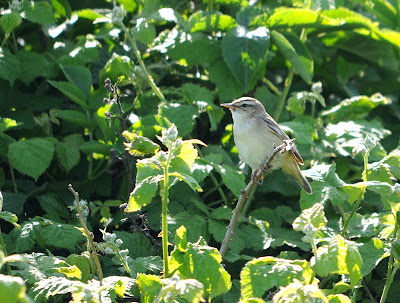I chased this Red Admiral around the car park before it deigned to settle on what looks like a pretty uncomfortable Gorse stem perch. The presence of other Gorse bushes just where I didn't want them to be meant this was the best angle I could get.
The ARC pit featured few birds, unsurprisingly in early summer. There were quite a few Greylags and Canadas, some Mute Swans, a Great Crested Grebe, passing Common, Herring, Black-headed and Lesser Black-backed Gulls and a large raft of Coots. Closer to hand were a couple more Coots, looking distinctly fed up with the demands of their two incessantly squeaking chicks.
Way across the other side of the pit, assorted raptors cruised - unidentifiably distant falcons (almost certainly all Hobbies) and just about identifiable Marsh Harriers. We walked around the other trail for a closer look. Not that much closer to be honest, but I have a weakness for sunlit birds against stormy-looking skies, and this male Marshie has a lovely clear pattern and colour combo.
We then went to the reserve proper. En route a Hobby flew right in front of us and I completely failed to get a picture, to my dismay. In the visitor centre, we read the news that Dengemarsh was the current hangout of the Red-foot, as well as the place for the Purple Herons. We set off at speed, but Rob had to turn back when he realised he'd left his tripod back at the ARC pits. I went on alone and walked fast to Dengemarsh, the most distant of Dunge's hides, though numerous birds waylaid me on the way around.
First to catch my eye was this female Reed Bunting, who'd clearly had more luck finding damselflies on the reserve today than I had. Tsk.
Next came this fine male Linnet, twittering sweetly away from a lichen-encrusted dead shrub. Even the promise of a Red-foot wasn't enough to tear me away... well, not for a few minutes at least.
Should I apologise for yet another Sedge Warbler photo? Well, they'll have migrated back to Africa before you know it so let's make the most of them. This one was interesting in that it was strikingly pale, not just overexposed.
And when I finally reached Dengemarsh hide? Not much to see. No falcons on view, no sign of any herons, Purple or otherwise. I amused myself photographing the assorted flyby birds, including this Common Gull, looking pretty in the strong slanting light.
 Rob showed up soon after, and got busy pointing the Sigmonster at the nearest birds - an Oystercatcher family on a raft in front of the hide. One of the adults was standing guard over at least two small chicks, while the other was going back and forth fetching little wiggly creatures for the babies. Helpfully, this bird announced its arrival well in advance with a volley of shrill piping calls, enabling Rob to get pics of it on the wing.
Rob showed up soon after, and got busy pointing the Sigmonster at the nearest birds - an Oystercatcher family on a raft in front of the hide. One of the adults was standing guard over at least two small chicks, while the other was going back and forth fetching little wiggly creatures for the babies. Helpfully, this bird announced its arrival well in advance with a volley of shrill piping calls, enabling Rob to get pics of it on the wing.I hadn't realised that Oystercatchers provision their babies with food - I'd assumed they just left them to forage for themselves as is the norm with precocial chicks. I suppose, though, this species does often nest on small islands and other spots where food may not be that easy for the little 'uns to find.
It was getting late, and we suspected we'd seen the last of the sun, so we headed back for the visitor centre. On the way, I failed to photograph several Whitethroats and a male Kestrel. This Red-legged Partridge took pity on me and stuck its head out of the long grass by the trail just as one last shaft of sunlight fought its way out of the gathering clouds.










No comments:
Post a Comment